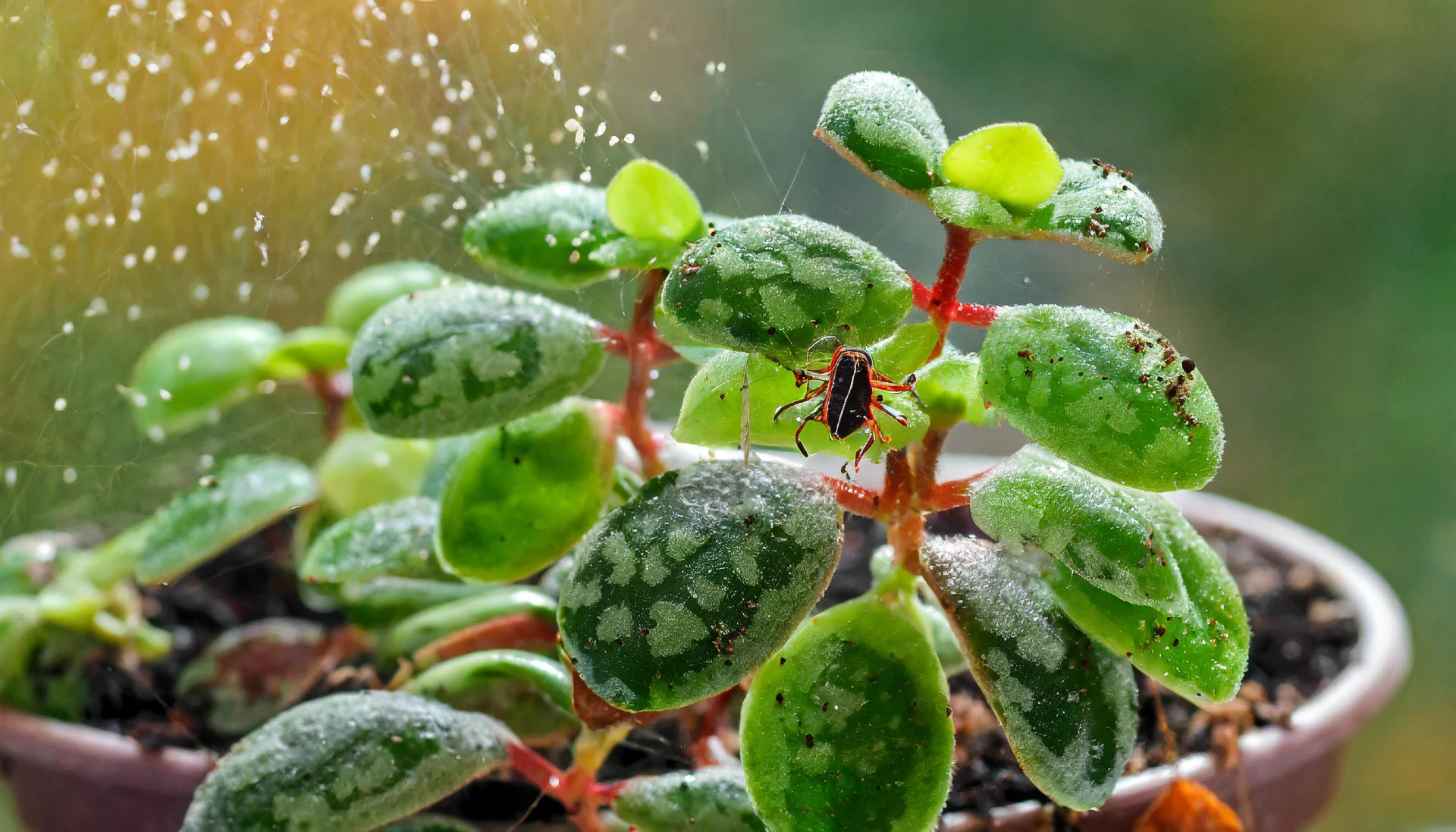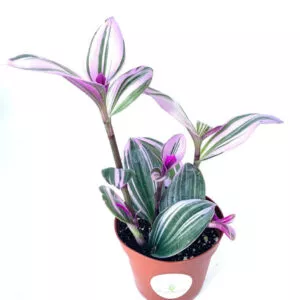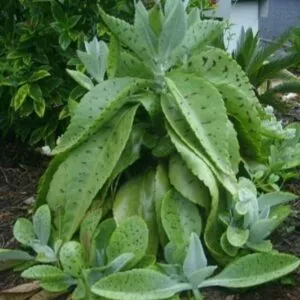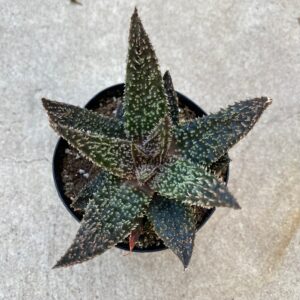No products in the cart.
This intriguing plant bears a resemblance to Hoya Serpens, albeit lacking variegation. Their shared trailing growth pattern and robust, succulent stems create a noticeable similarity between the two.
The string of turtles is an easy-to-grow semi-succulent perfect for beginners. This trailing plant is ideal for hanging baskets with its cascading stems covered in unique turtle shell-shaped leaves. This is a perfect plant to add to your houseplant collections.
In this complete growing guide, you’ll learn everything you need to know about successfully cultivating string of turtles, from ideal conditions to troubleshooting problems.
String of Turtles Overview

String of turtles, scientifically known as Peperomia prostrata, is a gorgeous vining plant native to South America. It earned its common name from the way its round leaves stack together resembling little green turtle shells. These succulent leaves are approximately 1/2 to 3/4 inch across, and have a slow growth rate with a peak growing season of spring through summer.
This plant is also called turtle vine, turtle tail, creeping buttons, and trailing jade. It belongs to a genus with over 1,000 recorded species. String of turtles is one of the most popular peperomias kept as a houseplant.
It has a spreading growth habit, with stems extending up to three feet long. New baby turtle leaves emerge from reddish-brown stems. The leaves are green with pale, striped markings.
One of the reasons this trailing succulent is such a joy to grow is how easily it propagates. Just snip off a stem section a few inches long and place it directly in the soil. Or pop a cutting in water until it roots. In no time you’ll have a baby string of turtles plant to add to your collection or share with friends.
String of Turtles Care Quick Guide
- Place in bright, indirect light or provide 14 hours daily of artificial grow light. Rotate pots to evenly distribute light exposure.
- Use terra cotta pots and an orchid potting mix to create excellent drainage and prevent soggy soil.
- Allow soil to nearly dry out between thorough waterings. Always empty the drainage tray after watering.
- Maintain average room humidity from 40-50% to mimic their native tropical environment.
- Propagate easily from stem cuttings rooted in water or soil for unlimited new plants!
- Repot every 2-3 years in spring, removing circled roots and pruning any long stems.
- Wipe leaves occasionally with a damp cloth to keep them dust-free and vibrant-looking.
- Feed monthly during spring and summer with a balanced liquid fertilizer diluted by half.
By mimicking its natural growing conditions, your string of turtles will flourish indoors and add a tropical vibe anywhere in your home. Enjoy watching the vines extend and fill out hanging baskets or trail over the edges of shelves.
Growing Conditions for String of Turtles

String of turtles is adaptable to average indoor environments. Here are the key conditions to provide this plant with optimal health.
Light Requirements
Bright, indirect light keeps a string of turtles happy. Direct sun is a final nail to their beautiful foliage. An east or west-facing window is ideal. A couple hours of morning or late afternoon sun is tolerated but avoid intense southern exposure.
If natural light is insufficient, supplement with artificial lighting for 12-14 hours daily. Rotating the pot ensures all sides receive even lighting.
Too little light results in weak, elongated growth and leaves losing their coloration. Place it just a few feet back from a sunny window to prevent leaf scorch.
Soil Needs
This peperomia requires a well-draining soil mix. Use quality potting soil amended with perlite, pumice, or sand to improve drainage. You can buy a ready mix of succulent soil in your local nursery.

Plant in a container with bottom drainage holes to prevent soggy soil. Avoid non-porous plastic pots which can lead to overly moist roots. The best pots for the string of turtles are terracotta.
Watering Habits
Allow the top inch or two of soil to completely dry out between waterings. The succulent leaves store water so prolonged drought is tolerated. Care not to overwater or soggy soil may cause leaf drop or root rot.
When watering, pour enough so it runs through the drainage holes. This leaches out any built-up fertilizer or mineral salts. Allow all excess liquid to drain fully before returning the pot to its decorative cover.
In hotter months, plants need more frequent watering. Back off in winter when growth naturally slows. Do not allow soil to dry out completely for extended periods.
Humidity and Temperature
String of turtles plant thrive in 40-50% relative humidity, much like that found in rainforests where it originates. Use a pebble tray or humidifier to increase moisture when indoor air is overly dry.

Ideal temperatures are between 60-80°F (15-26°C) for most tropical plants, especially for these gorgeous vining plants. Avoid placing pots in cold drafts below 50°F (10°C) which can damage leaves. Move plants away from hot radiators or heating vents as well.
Fertilizer Requirements
During the active growing period from spring to fall, feed monthly with a balanced liquid succulent fertilizer diluted to half strength. Or any organic matter like fish emulsion or vermicast. This provides key nutrients for growth. Stop fertilizing over winter when plants are dormant.
If your string of turtles plant becomes leggy or loses coloration, increase light levels before turning to fertilizer to correct the issue. Too much fertilizer can damage the sensitive roots.
How to Propagate String of Turtles
One of the easiest ways to get more string of turtles plants is through propagation. There are a few different methods you can use:
Stem Cuttings
Simply cut off a stem section a few inches long that has 3-4 leaves on it. Allow the cut end to callous over for a day or two. Then place the cutting in a moist potting mix deep enough to cover the bottom set of leaves.
Keep the soil slightly damp while roots are established. In about 4-6 weeks the cutting should be rooted and ready to pot up into its container.
Water Propagation
You can also root string of turtles cuttings directly in water. Place the trimmed stem in room temperature water, changing the water every few days.
Once roots are 1-2 inches long, plant the cutting in a moist potting mix. Transition it gradually to avoid transplant shock.
Soil Propagation
Allow long stems to trail over the edge of the pot and touch the soil. Where the nodes make contact, new roots will emerge.
Once these aerial roots are established, use a clean knife or shears to detach the trailing stem and plant it up on its own. Keep it lightly moist until actively growing.
Repotting Your String of Turtles
Repot string of turtles every 2-3 years in the spring, moving it to a container just one or two sizes larger. Or annually replace some of the soil mixture if the plant is staying in the same pot.

Use a porous terra cotta planter and an orchid potting mix or cactus soil amended with extra perlite for drainage. Before repotting, gently loosen any circling roots to encourage healthy growth.
Try to keep the original nursery soil intact around the roots when repotting to reduce transplant stress. Water well after repotting.
Prune off any long wiry stems to keep the plant full and compact. These prunings can be used for propagation.
Pruning
Because of its vining nature, string of turtles can become long and leggy over time. To encourage a more compact habit, pruning is recommended every few weeks during the active growing season. Use clean, sharp scissors to cut trailing stems back to an outward-facing leaf node.
Remove any dead leaves at the same time by pinching them off gently at the base. The succulent leaves and stems of string of turtles allow it to tolerate pruning quite well. Just avoid taking off more than one-third of the overall plant at one time.
For string of turtles houseplants, the ideal time to prune is during spring and summer. Plants grown outdoors in warm climates can be pruned year-round. After pruning, provide bright, indirect light to encourage the plant to regrow prolifically from the cut points. Routine pruning results in a fuller, bushier string of turtles specimens.
USDA Growth Zones

String of turtles is a charming succulent well-suited for USDA zones 9-11. With proper care, this trailing plant thrives in warm environments and bright light conditions. Provide well-draining soil, allow it to dry between waterings, and protect it from frost.
String of turtles brings unique texture and interest to containers or hanging baskets in hot, arid climates.
Encourage Blooming
Your string of turtles may produce tiny white flowers during the growing season. While the blooms aren’t showy, you can encourage flowering by providing optimal care.
Give your plant bright, indirect light from an east or west window if possible. Supplement with a grow light if natural light is insufficient. If treated as indoor plants, maintain average room temperatures between 65-80°F and moderate humidity around 40-50% RH.
Use a fast-draining potting mix amended with perlite or pumice. Allow the top inch of soil to dry out between waterings. During the growing months, feed monthly with a diluted balanced liquid fertilizer to provide nutrients that support blooming.
Prune back any damaged stems or leaves which can promote fresh growth and flowers. Allowing the plant to become root-bound before repotting may also encourage blooms.
While the string of turtles flowers are small, the plant propagates readily from cuttings. Focus on providing the optimal growing conditions and any blooms will be a bonus. The key is keeping your string of turtles healthy and happy!
-
Free Shipping$5.95Sold By: SunSoul Plants
$7.95In stock
Red Texas Star Hibiscus Seeds, Hibiscus coccineus seeds – 10+ seeds, free shipping
Rated 4.87 out of 5 based on 98 customer ratings00Sold By: SunSoul Plants -
$25.45Sold By: Carlo's Plant Farm
In stock
Sinese Ligustrum | Carlo`s Plant Farm
Only 6 available and it’s in 1 people’s basketRated 5.00 out of 5 based on 22 customer ratings00Sold By: Carlo's Plant Farm -
$66.21Sold By: Carlo's Plant Farm
In stock
6 Crape Myrtle Muskogee | Carlo`s Plant Farm
Rated 5.00 out of 5 based on 22 customer ratings00Sold By: Carlo's Plant Farm -
Free Shipping$13.95Sold By: SunSoul Plants
$20.95In stock
Callisia Fragans, ‘Family Doctor’ live plant – in 4″ pot, free shipping
Rated 4.87 out of 5 based on 98 customer ratings00Sold By: SunSoul Plants
Potential Problems With String of Turtles

String of turtles is quite resistant to issues. But here are a few potential problems to watch for:
- Leaf drop due to overwatering, low humidity, or cold drafts
- Leggy, weak growth from insufficient light
- Root rot due to wet soil
- Mealybugs or spider mites sucking juices from leaves and stems are common pests.
- Leaf spot or stem rot fungal diseases
Fortunately, these problems are largely preventable by providing ideal growing conditions. Ensure the plant receives enough indirect light, practice proper watering techniques, and use well-draining soil.
Remove any diseased or infested stems immediately to prevent spreading. Treat pests with neem oil or insecticidal soap sprays. Avoid overuse of chemical pesticides which may burn sensitive succulent leaves.
String of Turtles Similar Plants
String of pearls (Senecio rowleyanus): Rounder beads on trailing stems; needs more sunlight
String of bananas (Senecio radicans): Banana-shaped succulent leaves; fast-growing
String of hearts (Ceropegia woodii): Heart-shaped leaves, purple stems; lower light
String of nickels (Dischidia nummularia): Coin-shaped leaves; low light tolerant
String of dolphins (Senecio peregrinus): Blue-green succulent leaves resemble jumping dolphins; branching stems
Frequently Asked Questions
String of turtles requires bright, indirect sunlight. An east or west-facing window works great. Provide 14 hours a day of artificial light if natural light is inadequate. Avoid direct southern sun exposure.
Allow the top inch of soil to dry out between waterings, then thoroughly soak the soil until excess drains from the pot. Always pour out any collected water in the drainage tray after watering. Take care not to oversaturate the soil.
This tropical plant prefers average room temperatures between 60-80°F (15-26°C) and moderate humidity around 40-50% RH. Avoid cold drafts. Use a humidifier or pebble tray to increase moisture in dry air.
Leggy growth results from insufficient sunlight. Provide brighter light conditions to produce more compact growth. Prune back extra long stems and propagate the cuttings to start over with a fuller plant.
Avoid misting the leaves, which can promote leaf spot diseases. Increase humidity at the roots by using a pebble tray filled with water or humidifier instead.
Leaf drop is usually caused by overwatering, drought stress, temperature extremes, or lack of adequate lighting. Correct any care issues and resume proper conditions to reduce leaf loss.
Follow the tips and information provided above and you’ll be able to grow a healthy and thriving string of turtles plant that trails beautifully in hanging baskets.
Whether you want to buy, sell, or simply reach out to other plant enthusiasts, Plantly is the right place to be!
-
-
$9.99Sold By: Cacti and Exotica
In stock
Crassula ovata—Tricolor Jade
Rated 4.98 out of 5 based on 59 customer ratings00Sold By: Cacti and Exotica -
Free Shipping$19.99Sold By: Gar-Zen Botanical Design
In stock (can be backordered)
Kalanchoe Gastonis bonnieri Donkey Ear Ships Free.
Only 7 available and it’s in 2 people’s basketRated 4.86 out of 5 based on 49 customer ratings00Sold By: Gar-Zen Botanical Design -
$44.99Sold By: Succulent Oasis
In stock
Medium Succulent Plant – Star Aloe ‘Tarantula’ Hybrid. An extremely rare and very limited Aloe.
Rated 4.84 out of 5 based on 352 customer ratings06Sold By: Succulent Oasis










